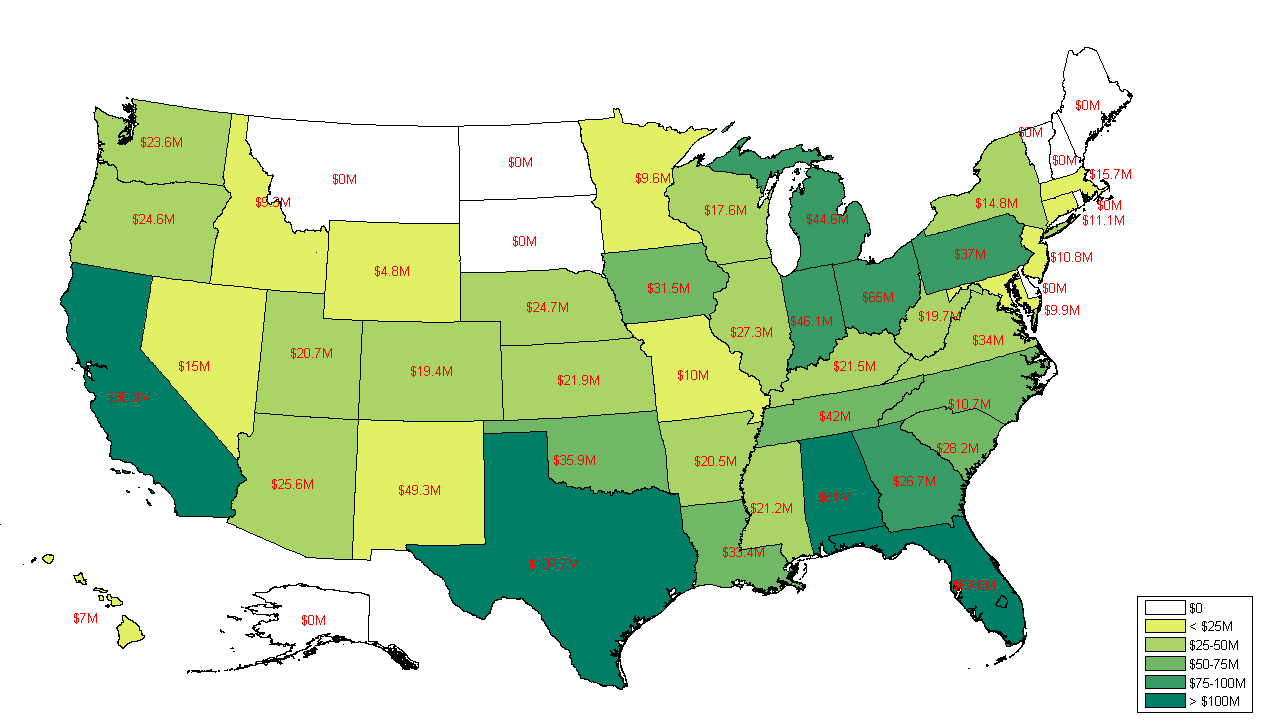While football season is behind us, the amount of money generated by the NCAA and its schools remains of interest to us. Thanks to our friend Wesley Turner, we have acquired data on all NCAA Division I schools for total football revenue and expense. Much of the data can be further investigated at USA today’s website, and when available at Equity in athletics .
As would be expected, the big name football factories spend the most money on football related expenses, but the amount of profit that is generated on average per year is staggering. Over the 7 year period of 2003 till 2009, the top 10 schools (Texas, Georgia, Florida, Notre Dame, Michigan, Alabama, Penn State, LSU, Auburn and Ohio State) generated more than $30 million in profit per year. Texas which generates on average almost $50 million a year, has seen incredible sustained growth. In 2003, their profit margin was $34.6 million. In the year 2009? $68.8 million!
In the past year, there was a large push by the Pac 10 (12) to extend to 16 teams by including Texas and 3 other Texas/Oklahoma schools. This push while stated as an opportunity to further increase quality of games, is rather purely monetary, with the BCS conference teams further fighting for their share of this amazingly large money base. The following graph displays the average football related expenses and revenue for 117 Div I schools from 2003-2009. Sorted by expense from top down, it is easy to see how the rich remain rich while the “little sisters of the poor” scrap for a piece of the pie.
We further investigated the location of each school, and how the US spends its money on college football. The colors represent revenue while the red numbers represent expense. Amazingly the state of Alabama is at the top for college football revenue, though the state remains generally poor in GDP/GSP related measures.
The NCAA is setup to be a non-profit organization, and while it is generally believed that football helps pay for other sports and school/conference expenses, the link here is missing. In fact 40 teams averaged a loss in money through football over the 7 year period. Its no wonder that some schools are willing to travel into SEC country year in and year out for a hefty payday even though its another guaranteed loss.
In the coming weeks, we will try to investigate expenses/revenue for other sports and see where the money trail takes us.
March 31 edit: If interested, you can also find a post detailing sport by sport expenses/revenue as well as gender differences in college sports .



Question if the NCAA is non-profit organization which makes schools sports programs non-profits as well, and the sports department should not be showing a profit, why is that NCAA is allowing profits to be reported by schools such as football and basketball.
Like a small businessperson, you have no greater leverage than the truth.
It takes more than capital to swing business. You have got to have the A. I. D. degree to get by – Advertising, Initiative, and Dynamics.
It would be interesting if you could take a look at other division’s . Like D2, D3, and the NAIA
To my knowledge this data does not take into account any alumni based revenue. It is quite possible that other money is brought in by a competitive sports team, as seen at the University of Oregon in recent years through Nike/Phil Knight money. Of course that money is specifically earmarked for sports teams, while the research departments see none of it. It seems to be self perpetuating, with the sports facilities having wonderful upgrades, while academia maintains itself in the doldrums.
I have heard about college applications to the UofO increasing tremendously after the Ducks made the Rose Bowl last year, so there is some incentive to the rest of the University. Of course like you said, I love sports just as much as anyone else, and love/hate institutions arbitrarily based on sports loyalties. Saturdays do break up the monotony of research at times, but I still hope to see a level playing field for all the teams, and with the NCAA being non-profit, you’d hope the benefits would be distributed appropriately. I’d have to investigate this further if I were to make any solid claims though.
Does this data account for the alumni giving effect of college sports? You also have to admit that there is some revenue generating effect in the two big college sports; they promote the school, they advertise the school, and potential students want to participate in the events as fans or players. I would be hard pressed to find someone who was deterred from an institution because of it’s sports programs.
I think we both have sufficient experience to say that the lack of a sports mentality makes a university a lot more boring, while it’s presence is a welcome break from academic and research monotony. This effects student, staff, and faculty quality of life, as well as alumni interest in the institution.
The challenge is to quantify the “intangible” benefits–and possible drawbacks–of the university sports programs. If you can do that, then you can probably burn your Bioengineering PhD diploma and use the space in the trophy case for your Nobel prize.